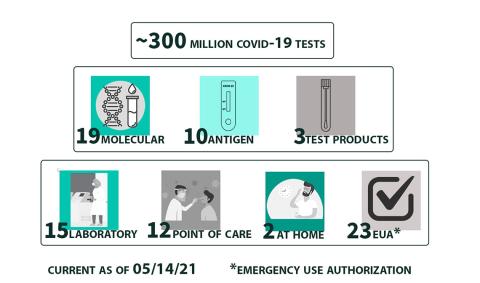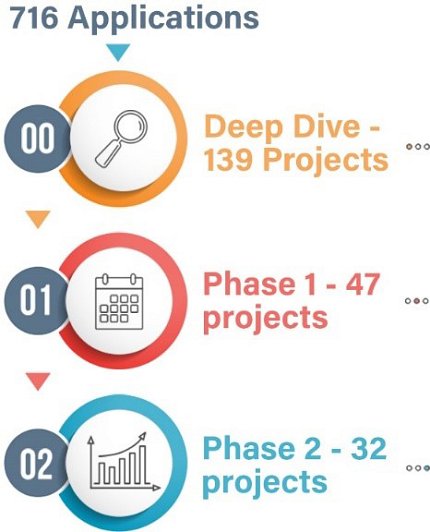Looking Back, Sprinting Forward
One Year of RADx Tech Success

Thinking back to a year ago when terror struck worldwide and the full weight of the Covid-19 pandemic began to set in, NIH quickly mobilized on multiple fronts—one of which was the Rapid Acceleration of Diagnostics (RADx) initiative, with the goal of helping to meet the huge demand for fast, accurate Covid-19 tests.
Fast-forward 1 year and about 300 million Covid-19 tests, NIH director Dr. Francis Collins and NIBIB director and RADx tech lead Dr. Bruce Tromberg hosted a RADx Tech Town Hall to commemorate the anniversary milestone. Last month, about 460 members of the RADx team were able to join the virtual event to celebrate the landmark.
Collins kicked off the event by reflecting on when then-U.S. Sen. Lamar Alexander (R-TN) asked whether NIH could help produce more Covid-19 diagnostic tests, which were desperately needed. Collins immediately thought of Tromberg because this was, after all, an engineering problem.
Tromberg described an existing structure at NIBIB that develops new diagnostics for infectious diseases, and thought it could be the perfect springboard to launch a larger, Covid-focused effort. To their surprise, NIH was allocated $1.5 billion to solve the diagnostics crisis and produce tests to help change the course of the pandemic.
“I was really excited and a little bit terrified—promising we could do things that I wasn’t sure were even possible,” Collins recalled. “But I need not have worried, because the RADx team we celebrate today had all the moxie necessary to deliver the results we needed.”
Next, listeners heard from Alexander and U.S. Sen. Roy Blunt (R-MO) on the genesis of RADx from their perspective, how it has impacted the pandemic and what is in store for its future.
Alexander highlighted the millions of tests RADx is producing each day, including at-home tests that take only 15 minutes. He underscored the continued importance of Covid-19 testing, even in light of the vaccines.

Blunt could not remember the last time someone complained that there weren’t enough tests—because now there are enough tests, thanks to RADx. He said scientists and innovators answered the RADx call for new technologies, and looking forward, he hopes the RADx model can be replicated for other health problems.
Next Tromberg recollected events from last year–specifically Apr. 24—the day Congress earmarked $500 million for NIBIB for Covid-19 diagnostics, which effectively doubled its normal budget. He underlined the importance of collaboration and coordination among NIH, the White House, HHS, BARDA, FDA, DoD and CDC to increase the U.S. testing capacity by more than 240 million tests (as of March 2021).
Collins then introduced Carole Johnson, national testing coordinator for the White House Covid-19 Response Team. She applauded the incredible work of the scientific community, which has supported a significant increase for testing, one of President Biden’s key response pillars. She highlighted the success of the RADx model and how its public-private partnerships have been essential in accelerating the diagnostics pipeline and will continue to benefit the country long after the pandemic has ended.
Next to present was Ingo Chakravarty, the CEO of Mesa Biotech—a successful RADx Tech company. Chakravarty recounted his tenure with the firm, which started only 2 short weeks before Mesa applied to RADx. At that time, he said they were only capable of producing about 16,000 Covid-19 tests per month, considered themselves under-resourced and had just 65 employees.
Fast-forward 10 months and they have produced more than 1 million Covid tests, have hired 1,200 employees and been acquired by Thermo Fisher—thanks to the support from RADx. “There’s a saying about building an airplane during flight,” he concluded. “What we’ve collectively done here is even more difficult. We have built a rocket ship during launch. I want to say thank you. It’s been an honor. Let’s make a big impact on the American people.”
The final presenter of the day was Dr. Harvey Fineberg, president of the Gordon and Betty Moore Foundation and former president of the National Academy of Medicine, who provided perspective on the value of RADx.
“The RADx program represents government at its best,” he said. “When the history of America’s response to the Covid-19 pandemic is written, two outstanding scientific achievements will stand out—the development of a safe and effective vaccine within a year and the acceleration of diagnostics.” He finished by emphasizing that the RADx process can be used beyond Covid-19, for diagnostics for precision medicine and precision public health.
Joining the Q&A discussion were Radm. Michael Iademarco, director of the Center for Surveillance, Epidemiology and Laboratory Services, and Dr. Tara Schwetz, former associate deputy director at NIH now working at the White House Office of Science and Technology Policy. She discussed how the other components of the RADx initiative leverage the infrastructure of its tech.
Iademarco conveyed the importance of increasing U.S. testing capacity in case a second wave hits and remarked that RADx has been a vital and central player in building U.S. capacity.
In a true celebratory spirit of RADx’s success, Collins played Covid Lemon Tree on guitar with lyrics written by Dr. Carrie Wolinetz, and Tromberg rewrote lyrics to a classic Bob Dylan song renamed Covid Testing Blues, as program credits scrolled on screen, like the ending to a movie.
